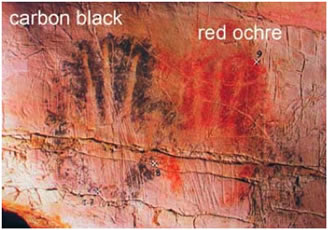First Paint Dated to 47,000 BCE
 |
www.webexhibits.org
|
South Africans used milk-
based paint 49,000 years ago
Scientists have discovered a milk-and ochre-based paint dating to 49,000 years ago that inhabitants may have used to adorn themselves with or to decorate stone or wooden slabs. An international research team led by the University of Colorado Boulder and the University of Witwatersrand in Johannesburg, South Africa has discovered a milk-and ochre-based paint dating to 49,000 years ago that inhabitants may have used to adorn themselves with or to decorate stone or wooden slabs.
While the use of ochre by early humans dates to at least 250,000 years ago in Europe and Africa, this is the first time a paint containing ochre and milk has ever been found in association with early humans in South Africa, said Paola Villa, a curator at the University of Colorado Museum of Natural History and lead study author. The milk likely was obtained by killing lactating buffalo, eland, kudu and impala, she said.
"Although the use of the paint still remains uncertain, this surprising find establishes the use of milk with ochre well before the introduction of domestic cattle in South Africa," said Villa. "Obtaining milk from a lactating wild bovid also suggests that the people may have attributed a special significance and value to that product."
 |
Credit: Villa et al. PLOS ONE, 2015
(A) MOD flake before sampling, scale bar = 1 cm.
(B) Detail of residue left after sampling for
chemical and proteomic analyses.
|
The powdered paint mixture was found on the edge of a small stone flake in a layer of Sibudu Cave, a rock shelter in northern KwaZulu-Natal, Africa, that was occupied by anatomically modern humans in the Middle Stone Age from roughly 77,000 years ago to about 38,000 years ago, said Villa. While ochre powder production and its use are documented in a number of Middle Stone Age South African sites, there has been no evidence of the use of milk as a chemical binding agent until this discovery, she said.
Cattle were not domesticated in South Africa until 1,000 to 2,000 years ago, said Villa. Wild South African bovids are known to separate from the herd when giving birth and usually attempt to hide their young, a behavior that may have made them easy prey for experienced Middle Stone Age hunters, she said.
 |
| The Plot Whisperer: Secrets of Story Structure Any Writer Can Master by Martha Alderson Click to order from Powell's Books |
At both African and European archaeological sites, scientists have found evidence of ochre -- a natural pigment containing iron oxide than can range from yellow and orange to red and brown -- dating back 250,000 years. By 125,000 years ago, there is evidence ochre was being ground up to produce a paint powder in South Africa.
It has been proposed the ochre was sometimes combined by ancient Africans with resin or plant gum to use as an adhesive for attaching shafts to stone tools or wooden bone handles, Villa said. It also may have been used to preserve hides and for body paint, she said, noting that a roughly 100,000-year-old ochre-rich compound blended with animal marrow fat was found at the Middle Stone Age site of Blombos Cave in South Africa.
Body painting is widely practiced by the indigenous San people in South Africa, and is depicted in ancient rock art. While there are no ethnographic precedents for mixing ochre with milk as a body paint, the modern Himba people in Namibia mix ochre with butter as a coloring agent for skin, hair and leather clothing, Villa said.
Related stories:
- 500,000 year old engraving discovered
- Ancient Crucible Steel Sword Discovered in Massacre Site
- Ancient metal workers were not slaves but revered craftsmen
- A Step Toward Understanding Arabic Language and Culture
- Ayla and Jondular had blue eyes, but were black
- Bad News: We're Not So Different From Earliest Humans
- Did a Volcanic Eruption Kill Off the Neandertals? Science Determines: Sorta
- DNA Research Shows a Mystery Population Invented Agriculture
- Farming culture traveled to Europe by boat, not overland
- Greek Bronze Age ended 100 years earlier than thought
- Here, kitty, kitty, kitty. Humans met sabre-tooth cats 300,000 years ago
- How Our Stone Age Ancestors Lived & Hid
- The Killing Advantage of Stone Tipped Spears
- Neandertal ritual or Neandertal cannibalism?
- Neolithic Scandinavians Rejected Farming
- The Newly Discovered 4500 Year Old Gold Road Across Britain
- Of Human Language: Fast or Slow to Develop?
- Oldest fortified settlement ever found in North America
- The Peaceful, Cooperative Maya Transition From Hunter-gatherer to Farmer
- The Quest for Fire, Revisited
- Roman Gladiators were vegetarians? Yes, and they drank ash tonics as well.
- Two thousand years of intellectual freedom mapped
- The Unknown Volcanic Eruption of 1808 & Mary Shelley's Frankenstein
- Was North America First Settled by Stone-age Europeans?
Story Source: Materials provided by University of Colorado at Boulder. Paola Villa, Luca Pollarolo, Ilaria Degano, Leila Birolo, Marco Pasero, Cristian Biagioni, Katerina Douka, Roberto Vinciguerra, Jeannette J. Lucejko, Lyn Wadley. A Milk and Ochre Paint Mixture Used 49,000 Years Ago at Sibudu, South Africa. PLOS ONE, 2015
Comments
Post a Comment